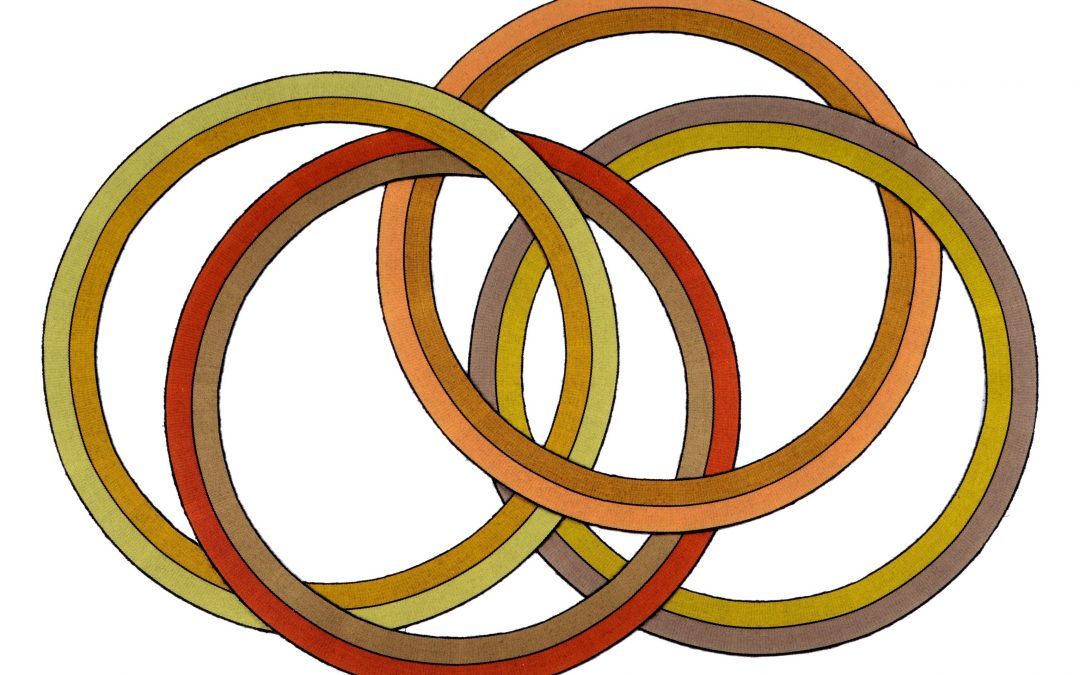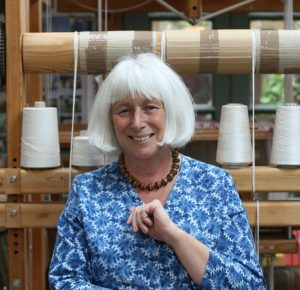 NAME: Deirdre Wood
NAME: Deirdre Wood
BACKSTORY: Deirdre’s work fascinates me, especially when she started exploring curved shapes through the use of yarn properties. She specialises in narrow strip weaving. I listened to a talk at a symposium and found it fascinating to hear how she got into this particular field. She studied for a textiles degree at Farnham twenty five years ago and uses natural fibres to create three dimensional architectural tapestries by twisting and turning the woven fabric before being joined by sewing with her latest work exploring the possibilities of curved strip-weaving.
HOW I GOT INTO WEAVING
I had always enjoyed making things as a child, but rather lacked the skills or the knowledge to see where this could lead. When I was 17 my parents suggested that I work in a bank, after first following a domestic science course at the local technical college.
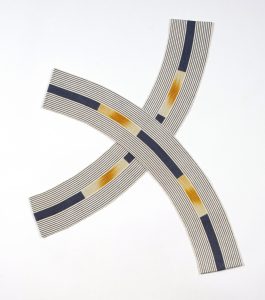
Luckily, I made my escape by enrolling on an art Foundation Course at my local art college, the Berkshire College of Art. The experiences of art school exposed me to the exciting possibilities of three-dimensional design in both sculpture and ceramics. I then progressed to Farnham School of Art where I began a ceramics course in 1968. At Farnham I learnt to throw – one of those challenges that takes a great deal of practice to understand the nature of form and how to realise these forms in clay. I think it may have been these early beginnings with clay that influenced my three-dimensional work in textiles. Although I loved throwing it was my total lack of any science education at school (a gas-lit school for young ladies) that was the real problem, particularly when it came to the complexities and pitfalls of glaze composition and kiln-firing.
I married the potter Nigel Wood while I was at Farnham, and then helped to set up a large pottery workshop at West Meon in Hampshire. But I was soon busy ‘at home’ with two young daughters, with regular pottery work now becoming less practical. Even so, my creative instincts were undiminished and I tried my hand at basket-making which, looking back, is a craft half way between pottery and weaving. I bought several bolts of willow from growers in the Somerset Levels and made some acceptable baskets. However, without the benefit of traditional training it was difficult to take the basket-making further.
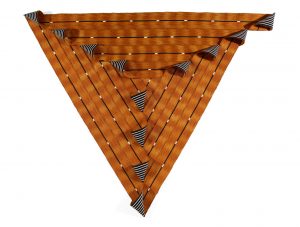
The turning point in my career came from a discovery of three cones of wool on a local market stall in Petersfield, selling mostly coloured acrylic yarn. I did not realise this at the time, but this was 2/8 worsted wool from Black Welsh Mountain, Herdwick and Welsh sheep. I had no idea what to do with the wool, but I bought it anyway (one cone per week!) as the rich subtle colours and the character of these yarns immediately appealed to me.
I then acquired a knitting machine and taught myself to use it – soon producing endless ‘made to measure’ patterned jumpers inspired by Baltic, Scandinavian, Scottish, Fair Isle and Peruvian designs, all made from the undyed wools of hill and mountain sheep. I sold these at craft and agricultural shows across the country. I enjoyed the constraints of designing within the rigid 24 punchcard repeat system, using the natural colours found in different sheep breeds. This was my occupation for ten years and it worked well with the demands of a young family.
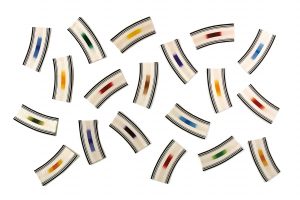
But I knew that there was much more to learn and it was the weaver Ann Richards, whom I first met as a customer who encouraged me to apply to Farnham (by now the West Surrey College of Art and Design) to study textiles – the same college where I had studied ceramics more than twenty years earlier. The first year was a wonderfully comprehensive and structured introduction to both weave and print techniques, as well as to the skills needed to achieve consistent colours by dyeing. But it was the discovery of West African strip weaving in Farnham’s teaching collection of world textiles that was truly inspirational. The fresh and lively designs were simply magical to me.
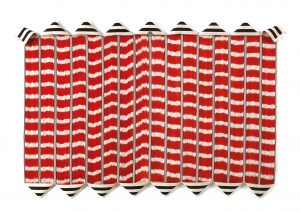
After graduating from Farnham and with the help of a Royal Society of Arts Travel Award I travelled to Mali, a land-locked country in the middle of West Africa to study the strip-woven Bogolanfini (mud-cloths), which had been the subject of my dissertation, and the indigo textiles made by the Bamana and Dogon people. My experiences from this field trip in Africa have been a continuing source of inspiration for my own textiles. It led me to explore a new world of twisted woven strips and, more recently into strip-weaving lengths that transform themselves into large circles by using contrasting yarns with different shrinkages across the warp.
Images: Main: FOUR INTERLOCKING RINGS. 135 x 100cm. Silk, linen and wool; From top: RUNNING CROSS. 74 x 74cm. Silk, linen and wool; GINGER IKAT SPIRAL TRIANGLE.122 x 107cm. Dip and Ikat dyed. Silk, cotton and wool; NINETEEN SPACED ARCS. 240 x 160cm. Silk, linen and wool; SNAKED IKAT CONSTRUCTION. 148 x 104cm. Silk, cotton and wool with silver detail. (Collection of the Whitworth Art Gallery, Manchester).
Website: http://www.deirdrewood.com/
NEXT TIME: Robyn Spady

